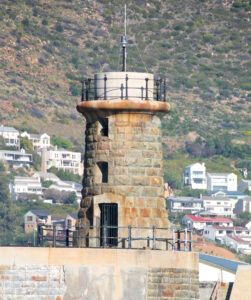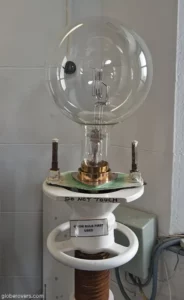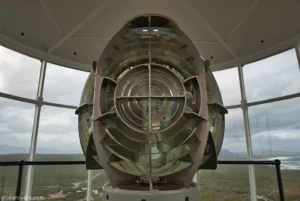
Did you know the study of lighthouses is called pharology? Lighthouses are generally towers built on the shore or the seabed to warn sailors of hazards and to assist them in establishing their position. The distinctive shapes and colours help mariners identify them during the day. A lighthouse may be painted all white if its surroundings/background is dark. The coloured stripes help the mariner identify the lighthouse if it’s up against a white background, such as cliffs or rocks. The flash patterns of the light identify them at night. Sometimes there is a coded radio signal that accompanies the light. Lighthouses in fairly close proximity to each other have different flash patterns to allow the mariner to identify their location. Some lighthouses in different geographical areas share the same flash patterns.
The height of a lighthouse takes into account the curvature of the earth, When the light is higher it can be seen from further away. The light cannot be so high up that local sailors will not see it. Shorter lighthouses are found on the top of cliffs and taller lighthouses are built nearer the shore.
Automatic sensors can determine if there is extra moisture in the air, and are able turn on the fog signals. Radio signals are also used to communicate with the ships
Since electronic navigation systems have been developed the role of lighthouses is waning. However, smaller lights and lit buoys are used to guide ships through busy and dangerous coastal waters and approaches to the harbour.


These are still needed for vessels that do not have sophisticated and expensive equipment systems.
Navigating unfamiliar waters has always been a challenge for sailors. When mariners sailing on voyages of discovery were looking for the best route around the continent of Africa without maps, the safest way was to sail as close to the shore as possible, that is to keep the land in sight the whole time. Sometimes the view was obscured by bad weather or fog and there was always the chance of running aground on a submerged island or hitting a hidden obstacle.
There is always a natural preference amongst sailors for the reassurance of visual navigation. Hence lighted marks are an advantage at night.
The earliest recorded lighthouses were beacon fires set up on hilltops. There are references to these in the Iliad and the Odyssey (c. 8th century BCE). The first actual lighthouse tower was the Pharos of Alexandria. It stood at 110 metres. This is where we get the term Pharology which is the study of lighthouses. The Romans while expanding their empire constructed many lighthouses. There are at least 30 known to have been in service from the Black Sea to the Atlantic. The famous lighthouse at Ostia in the port of Rome was completed in 50 CE. There is even a piece of a Roman lighthouse that can be seen in Dover England. The Romans traded from the Mediterranean to Great Britain and built lighthouses to mark their route. These were wood fires or torches that burned in the open.
After the first century CE, oil lamps were used in lanterns with glass panes. During the dark ages when there was a steep decline in commerce and travel, lighthouses were not regarded as necessary.
When trade in Europe was revived around the eleventh century, new lighthouses were built and can be found more often in travel books and charts/maps from that time. By 1600 there were at least 30 beacons around Europe.
When the voyages of discovery began, there were unknown hazards that many boats sadly encountered. The first lighthouse on the Southern Cape coast was Greenpoint Lighthouse.
Below are some of the terms used in the “lighthouse business”
Lighthouse terminology
- ARLHS: Amateur Radio Lighthouse Society.
- Acetylene: This is a fuel that began to be used in lighthouses after 1910. It was the first fuel used where a keeper was not required to carry oil up the tower. It could be stored on the ground and an automatic sun valve could turn the light off when it got light.
- Aerobeacon: A searchlight-type light originally designed for use at airports and adapted for use in several lighthouses.
- Aid to Navigation: Any device installed such as a buoy, beacon, lighthouse, or lightship built or maintained to assist navigation.
- Alternating (abbreviation “Al”): A light that shows alternating colours.
- Arc of Visibility: The portion of the horizon over which a light can be seen to help ships navigate.
- Argand Lamp: A hollow single-wick oil lamp. It was named after Ami Argand, the Swiss inventor who designed it.
- Astragal: Metal bar (running vertically or diagonally) dividing the lantern room glass into sections.
- ATON: Aid To Navigation.
- Automated: A lighthouse that operates without the aid of a keeper. The light is controlled remotely.
- Beacon: A fixed aid to navigation with or without a light.
- Bell: A bell sound made by a hammer that works by electricity. It is sometimes sounded by the motion of the sea on buoys.
- Breakwater: A fixed or floating structure that protects the shore harbor, anchorage, or basin from waves.
- Bug Light: A very small tower.
- Bull’s-eye Lens: A convex lens used to focus light.
- Caisson Style Tower: This is a lighthouse built on an iron caisson. A caisson was essentially a hollow tube made of heavy rolled-iron plates. The caissons were bolted together on land and transported into place, then sunk and filled with sand, gravel, rock, or cement. They were sometimes called coffee pot lights or bug lights. After the invention of the internal combustion engine, they became known as spark plug lights.
- Candela (abbreviation “cd”): This is the base unit of luminous intensity in the International System of Units (SI); ie:, luminous power per unit solid angle emitted by a point light source in a particular direction. A candle emits light with a measured intensity of one. The name “candle power” is still sometimes used.
- Cast-iron Tower: Usually cylindrical, these lights were popular in the 1840’s. Cast iron is stronger than stone and comparatively light. These could be manufactured in a foundry, and transported to the construction site.
- Catwalk: A narrow walkway, leading up to light towers that are built out in the water.
- Chariot: The wheeled carriage at the bottom of a Fresnel lens assembly, which allows the lens to rotate around a circular iron track atop the lens pedestal.
- Refract: Bend or slant of the rays of light.
- Revetment: type of retaining wall facing placed on a bank or bluff of stone to protect a slope, embankment, or shore structure against erosion by wave action or currents.
- Revolving Light: A light that flashes due to the rotation of the Fresnel lens.
- Rhythmic Light: An intermittent light that flashes with a regular pattern.
- Riprap: A loose arrangement of broken rocks or stones carefully placed to help stem erosion.
- Screw-pile Towers: These are built on poles that were “screwed” into the seabed. These often supported a small wooden building with a tower and a light on top of it.
- Sector: The area of the sea covered by the light from a sector of the light beam.
- Shoal: A shallow area, such as a sandbar or rock formation.
- Siren: A sound signal, which uses electricity or compressed air to actuate either a disc or a cup-shaped rotor.
- Skeleton Tower: Towers that consist of four or more strongly braced legs often the keeper’s quarters or work rooms are within these, and the beacon is on top. Their open design offers little resistance to the wind and waves and has withstood many storms. They are also used onshore where the land cannot sustain the weight of a masonry tower.
- Solar-powered Optic: Main lights today are powered by solar-charged batteries.
- Sound Signal: A sound, transmitter that provides information to mariners, when there is restricted visibility.
- Spark Plug style light: A Caisson tower that looks a bit like a car’s spark plug.
- Spider Lamp: Shallow brass pan containing oil and several solid wicks.
- Stag Light: A lighthouse maintained by single men.
- Tender: A vessel used when servicing the lighthouses and the buoys.
- Tower: Structure that supports the lantern room of the lighthouse.
- Twin Light: A few lights used to consist of two separate lights to distinguish them from other nearby lights.
- Ventilator: “Ball” at the top of most lighthouse towers that provide exhaust for the heat of the lamp and for air circulation inside the tower.
- Watch Room: A room, that is usually beneath the lantern room, It has windows so a lighthouse keeper can observe water conditions during storms.
- Whistle: An air or wave-actuated sound signal. The sound is produced by compressed air forced through a slot into a cylindrical bell chamber.
- Wick Solid: A solid cord used in spider lamps it draws the fuel up to the flame by capillary action.
- Wickie: A name given to lighthouse keepers, that comes from the task of trimming the wick of the
See lighthouses on Colourdots
Simon’s Town Lighthouse; Cape Agulhas Lighthouse; Danger Point Lighthouse; Cape St Blaize Lighthouse: Quoin Point Lighthouse: Dassen Island Lighthouse: Stompneusbaai Lighthouse; Groenriver Lighthouse; Robben Island Lighthouse; South Head Lighthouse; Cape Point Lighthouse; Romam Rock Lighthouse; Hangklip Lighthouse; Slangkop Lighthouse; Cape Colombine Lighthouse; Kalk Bay Lighthouse; Greenpoint Lighthouse. Milnerton Lighthouse

